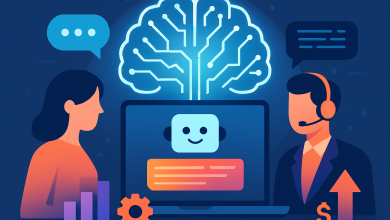
Your employees have been using AI since they had their first taste of ChatGPT. They’re trying new tools on their own time and figuring out what works. Meanwhile, most companies are just now trying to build an official AI strategy, and the gap between what people are already doing and what leadership is planning keeps getting wider.
And that gap is real. 90% of employees use AI tools in their personal lives, while only 40% have access through official company channels. When leadership finally sees this, the response splits.
Some organizations stay quiet, and nobody talks about what’s actually working or what risks they’re taking on. Others mandate widespread action immediately. “We need to be AI-first. We need to get everyone using these tools. We need to move fast.”
So everyone springs into action. Teams start running experiments, forming committees, allocating budget, and from the outside, it looks like progress. But without a more strategic approach, you’re hoping your teams randomly find their way to success.
This is the AI readiness disconnect that’s harder to spot. Some people are afraid of AI and others are resisting it. But what about companies running full speed in twelve different directions at once?
When leadership says go, everyone scrambles
I’m seeing this with most companies I talk to lately. Their CEO announces they’re going AI-first, the executive team nods, the directive goes out, and within weeks teams are running at full speed.
They stand up pilots, launch assessments, organize hackathons, and bring in thought leaders. They start building internal champions. On paper, it looks exactly like what an AI-first company should be doing.
But when I talk to the teams responsible for executing on these mandates, the story changes. They see the resistance. They see the gaps in leadership needed to drive this kind of change across the organization. They know how wide the gap is between the vision and their ability to execute on it, and they feel the pressure to show activity so leadership sees them doing something.
They’re spending money and burning out their best people, and nobody can tell you what success would even look like.
I’ve watched this same pattern play out since my years at Salesforce, where leadership would announce a major shift and everyone would rush to comply. The directive is clear, the scramble is immediate, and the results are mixed because people don’t understand the outcome they’re supposed to reach or how to work effectively together to drive real change.
Three ways random activity fails
When organizations mandate AI adoption without strategic direction, the work falls into three buckets, and all of them waste time and money.
First, great work stays isolated. Someone in marketing figures out a workflow that saves their team ten hours a week. Someone in customer success builds a prompt that dramatically improves response quality. These wins exist, but there’s no way to capture them, understand why they worked, or replicate them across the organization.
Second, activity masquerades as value. Teams run pilots for the sake of running them, chasing activity metrics instead of business outcomes. Attendance at the lunch-and-learn is high, but nobody can point to a process that improved or a result that shifted.
Third, security and alignment risks multiply. People grab whatever solves their immediate problem. They put company data into free AI platforms because it’s faster than waiting for company-approval, and they try tools that don’t align with the company’s AI vision or data governance policies.
None of this happens because people are careless, it happens because activity without strategic direction is just a lot of random motion. Hoping that people will randomly find their way to AI success is not a plan.
The gap is leadership readiness
Most organizations are treating AI readiness as a technical training problem. They’re investing in tools and teaching people how to write prompts and offering certifications in AI literacy.
Technical fluency is critical. There’s no path forward without it. But it’s only half of what organizations actually need.
The gap holding organizations back is leadership readiness. Leaders are being asked to set strategy for technology they don’t fully understand. They’re supposed to guide teams through changes they haven’t experienced themselves, and they’re doing all of this while managing their own uncertainty about what AI means for their role.
When leaders don’t have support to navigate this transition, the entire organization feels it. Strategic direction gets replaced by reactive scrambling, and the technical training that companies invested in doesn’t translate to business impact because nobody’s connecting the dots.
Ninety-five percent of companies report no measurable business impact from their AI investments. The technology works and the tools are powerful, but companies haven’t built the leadership support needed to turn any of that activity into actual results.
What separates the 5%
Research on the 5% of companies actually seeing results found they all had leaders doing five specific things. They stay strategically agile, human-centered, curious, performance driven, and lead with ethics.
In practice, that means leaders engaging their teams in the change. They help people understand the why behind it and build the trust needed for teams to let go of old ways of working and embrace something new with AI. When someone discovers what works, leaders create space to evaluate it, learn from it, and scale it across the organization.
It means connecting AI adoption to business outcomes from the start. Teams aren’t running pilots for the sake of it. They’re testing hypotheses tied to specific performance goals, and they can explain how the work ladders up to strategy.
And it means investing in leadership readiness alongside technical training. Leaders get the support to navigate their own learning curve, set direction, make trade-offs, and guide their teams through ambiguity. They’re not pretending to have all the answers, but they’re equipped to ask the right questions and help their teams figure this out together.
This is both/and thinking, not either/or. Technical training is critical. Leadership development is equally critical. Organizations that treat AI readiness as purely a technical challenge will keep driving activity that doesn’t deliver results. Organizations that invest in both will separate from the pack.
Your employees are using AI. Now what?
Your employees aren’t waiting for permission. They’re already using AI, either quietly on their own or because leadership told them to move fast. Either way, it’s happening.
The question is whether you’re ready to make it matter. The organizations that get this right aren’t doing more. They’re doing less, but with actual strategic direction. They’re building the leadership support that lets people connect the dots between what they’re learning and what the business actually needs.
And they’re treating leadership readiness as just as critical as technical training, because it is. Some companies will figure this out. The rest will watch them pull ahead.




